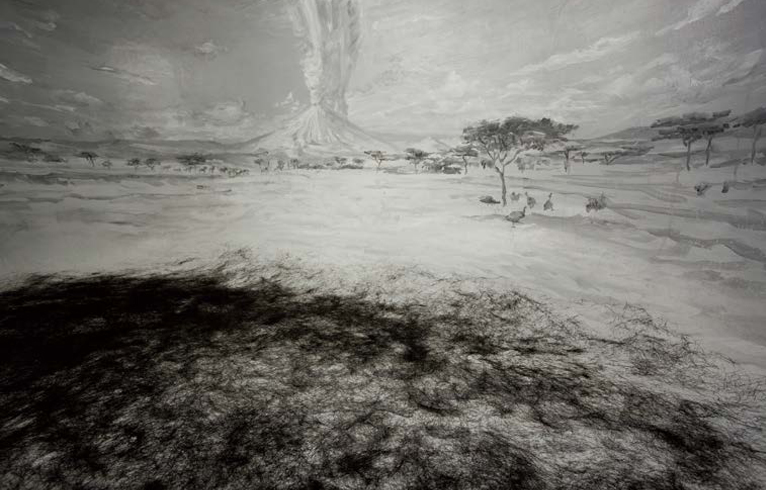LI QING: INTERWEAVING
| November 8, 2012 | Post In LEAP 16

If the title “Interweaving” is intended to convey a state of intermingling, then that is approximately the feeling that Li Qing’s solo exhibition ultimately gives the viewer: an encounter with intricate and gentle obscurities. At the very least, I am not able to use clear or precise words to summarize my sensations and feelings. To this end, the uncertainty and fluidity that “interweaving” suggests is precisely what makes the experience most moving.
A wary anxiety permeates the exhibition’s narrative and the visual impressions it leaves, from the two-screen video Xu to the paintings Magic and Descent to Island of Desire. The apprehension felt in these new works is not the result of image construction, but a questioning of the constructive process itself— scattered experiences of sensibility and their countervailing, rational conclusions. The works are juxtaposed with rational views of reality, retracing paths back to remnants of the coincidences that created the vacancy later filled by rational knowledge. By expressing doubt, Li attempts to induce his audience to review their own unquiet questions about the world.
Even if they manage to trace back to the first light of civilization, Li Qing’s works never reveal any sense of satisfaction with this— that would be greedy. In Images of Mutual Undoing and Unity: Evolution, a prehistoric caveman’s profile and the folds of fabric from an ancient statue mutually deconstruct; the result is two mirror images. With that binary relationship destroyed, the memory chaser’s location along the timeline becomes less clear, and the act of remembrance is no longer a return to utopia, but an imagining of the cracks in reality.
This is a crude revelation. On one hand, it doubts our motives when we yearn after objects, unaware of how our positions have been formed in the context of reality. On the other hand, we are hopeless in the face of this doubt, because our steps subconsciously return to the point of view that we oppose. In Showcase of Natural Science, the Museum of Natural History in New York attempts to use scientific objectivity to show human evolution. The artist, however, removes the human from the landscape, leaving behind only a set of footprints and hair. Li has intentionally introduced doubt in this installation. Without the protagonist, the scene is incomplete, the science muddled. This confounding behavior touches upon an interesting topic: Can art answer the need for objective understanding of the world? Is it an annotated version of reality? Li does not seem to think so. He has renounced the urgency of reconstructing the order of reality through art. He does not make promises about the future, but instead takes a moderate stance.
Supposing art is not just the visual transmission of rational thought, then it is no longer a tool for explanation. In Goya’s Trees, Li has placed the vantage point within the artistic system: there are background trees painted by the artist, a print of the original Goya, whitewashed canvas, actual tree branches, clothing in place of the dead bodies (including the hat that recurs in Li’s other works), and shadow drawn out by hand. These, each appearing as the counter-representation of another, no longer have clear purpose, position, or boundaries. Instead, they form a relationship in flux. Just as in Kafka’s The Castle, it is hard to distinguish the protagonist. Placed in such a setting, the art of painting seems awkward, almost sad, and with nothing to lean on. Painting is no longer an independently existing world; the area where its gaze falls is no longer a comprehensible whole.
Overall, one sees that Li Qing no longer presents the relative value of one work, but an interrelated system of existence— such as one where I mistakenly believe that I see you, while you pretend to contemplate whether my belief is realistic. The most moving moment is this: A world, serendipitously depicted by art, that is constantly removing the firewood from underneath its own cauldron.
Cui Cancan (Translated by JiaJingLiu)


